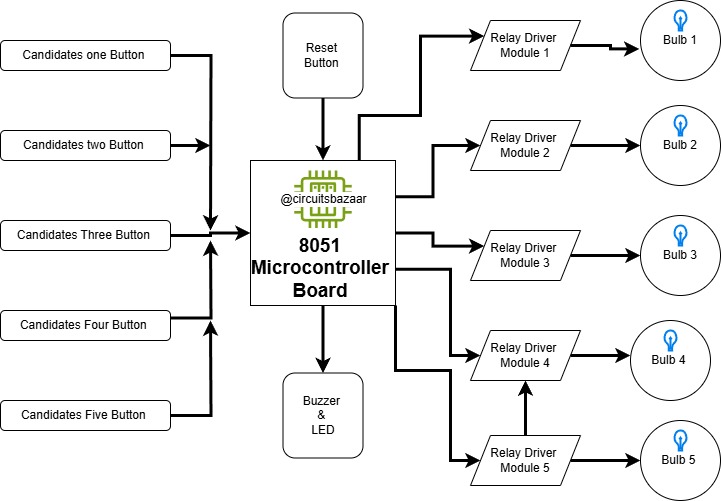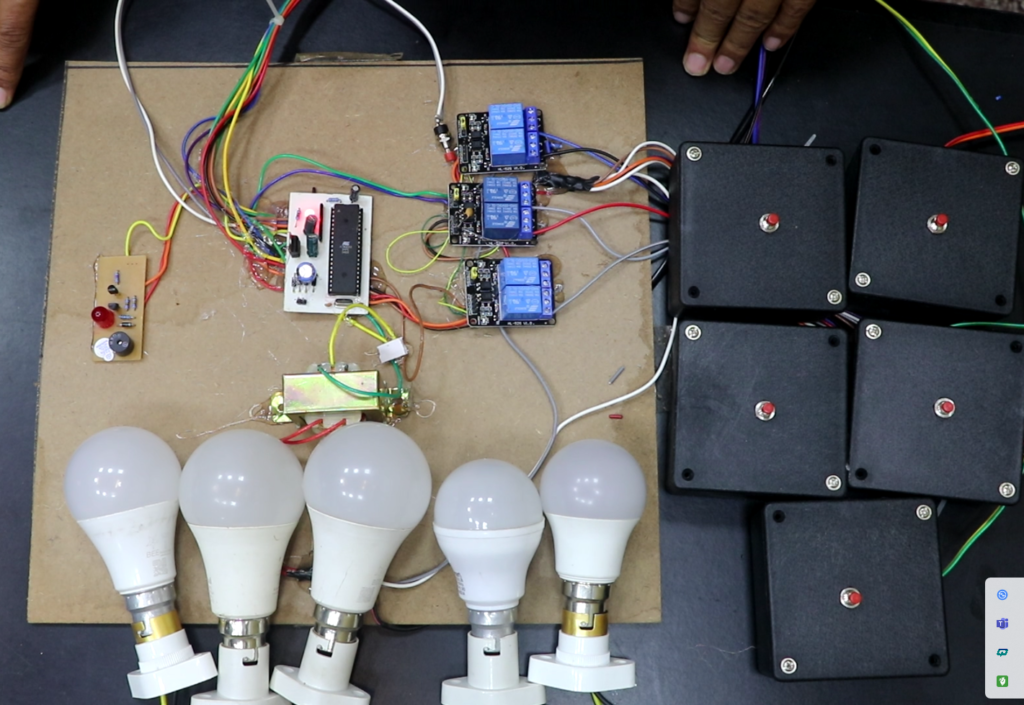8051 Projects
Five Candidates Quiz Buzzer Using 8051 Microcontroller – A Complete Guide
Are you looking for an innovative electronics engineering project that stands out? If yes, then this Five Candidates Quiz Buzzer system is perfect for you. This project is built using an 8051 microcontroller, dual relay boards, push buttons, buzzer, LED indicator, and 230V AC bulbs to create an efficient and reliable quiz buzzer system.
This quiz buzzer project is designed for quiz competitions, game shows, and educational institutes, ensuring fair play by allowing only one participant to press the buzzer at a time. Once a candidate presses their button, the corresponding bulb, buzzer, and LED indicator turn on, locking the system until the reset button is pressed.
In this detailed blog, we will explore:
✅ Introduction to the project
✅ Components used
✅ Block Diagram
✅ Circuit Diagram
✅ Video Demonstration
✅ Working mechanism
✅ Applications of the project
✅ Advantages and disadvantages
✅ Future scope & enhancements
✅ Conclusion
Let’s get started!
Introduction to the Five Candidates Quiz Buzzer System
A quiz buzzer system is widely used in game shows, quiz competitions, and educational contests to determine which contestant pressed their button first. This project is an advanced version of a traditional buzzer system, allowing up to five candidates to participate.
How Does This Project Work?
- When a participant presses their push button, their corresponding AC bulb, buzzer, and red LED indicator turn on.
- Until the reset button is pressed, no other buttons will be able to register an input.
- The reset button ensures fair play, allowing the system to reset and take the next input.
This system is perfect for schools, colleges, TV quiz shows, and competitive exams, making it a great engineering project for students.
Block Diagram:-

Circuit Diagram:-

Video Demonstrations:-
In Hindi Language:-
In English Language:-
Components Used in the Project
To build this Five Candidates Quiz Buzzer System, the following electronic components are required:
1. 8051 Microcontroller
The 8051 microcontroller acts as the brain of the system, processing inputs from the push buttons and controlling the relays.
2. Dual Relay Boards
The relay modules help in switching the 230V AC bulbs ON/OFF when a button is pressed.
3. Push Buttons
Five push buttons are used, one for each candidate. A reset button is also included to restart the system after each round.
4. Buzzer
A buzzer sounds whenever a button is pressed, providing an audio indication of the fastest candidate.
5. Red LED Indicator
A red LED indicator turns on along with the buzzer, providing a visual cue that a button has been pressed.
6. 230V AC Bulbs
Each participant has an assigned bulb, which lights up when they press their buzzer.
7. Power Supply
A regulated power supply is required to run the microcontroller and other electronic components.
With these simple components, we can build an efficient and reliable quiz buzzer system that ensures fair play.
Working Mechanism of the Five Candidates Quiz Buzzer System
Understanding the working mechanism is crucial for anyone looking to implement or modify this project. The Five Candidates Quiz Buzzer System operates using a simple sequential control mechanism driven by an 8051 microcontroller.
Step-by-Step Working Process:
- System Initialization:
- When the system is powered on, all bulbs, the buzzer, and the LED indicator remain OFF.
- The system is ready to take input from any of the five candidates.
- Button Press Detection:
- Each of the five candidates has a push button assigned to them.
- As soon as a candidate presses their button, the 8051 microcontroller detects the input and triggers the corresponding AC bulb, buzzer, and LED indicator.
- Locking Mechanism:
- Once a button is pressed, the system locks itself to prevent multiple inputs.
- Even if other candidates press their buttons, the system will not register new inputs until the reset button is pressed.
- Visual & Audio Indication:
- The buzzer sounds, indicating that a candidate has pressed their button first.
- The red LED indicator lights up as a visual confirmation.
- The corresponding AC bulb turns ON, identifying the fastest contestant.
- Resetting the System:
- The system remains locked until the reset button is pressed.
- Pressing the reset button turns OFF the bulb, buzzer, and LED indicator, making the system ready for the next round.
Why is This System Important?
This system ensures fair play in quiz competitions and avoids conflicts by clearly identifying the first participant to press the button.
Applications of the Five Candidates Quiz Buzzer System
This microcontroller-based quiz buzzer is highly useful in various real-world scenarios:
🎓 1. Educational Institutes & Schools
- Used in school and college quiz competitions to determine the fastest responder.
- Helps in conducting inter-school and national-level quizzes.
📺 2. Game Shows & TV Competitions
- Widely used in TV quiz shows and reality game competitions.
- Ensures a quick response mechanism to identify the first contestant.
🏆 3. Competitive Exams & Talent Shows
- Can be used in fastest-finger-first rounds in competitive examinations.
- Helps in talent hunt competitions where the first response matters.
🎛 4. Office and Business Events
- Used in corporate events, team-building activities, and fun quizzes.
- Can be implemented in polling or decision-making systems.
🔬 5. Research & Development in Automation
- Used in robotics, embedded systems projects, and industrial automation experiments.
This wide range of applications makes the Five Candidates Quiz Buzzer System a must-have for quiz-based competitions!
Advantages & Disadvantages of the Quiz Buzzer System
✅ Advantages:
✔ Fair Competition: Ensures that only one candidate’s response is recorded, avoiding confusion.
✔ Clear Identification: The buzzer, LED, and AC bulb provide clear indications of the first responder.
✔ Easy to Use: Simple design and user-friendly interface make it easy for anyone to operate.
✔ Reliable and Fast: Works efficiently using an 8051 microcontroller with a quick response time.
✔ Automation Ready: Can be enhanced and modified for wireless applications or online gaming setups.
❌ Disadvantages:
❌ Limited to 5 Participants: Can only accommodate five contestants at a time (can be expanded).
❌ Manual Reset Required: The system requires a reset button to be pressed before starting a new round.
❌ Wired System: Requires physical wiring, which may not be ideal for large-scale quiz events (can be improved using wireless modules).
Despite these minor limitations, this project is one of the best innovations for quiz competitions.
Future Scope & Enhancements of the Quiz Buzzer System
As technology advances, this project can be further improved and modified to meet modern requirements. Here are some future upgrades:
🚀 1. Wireless Quiz Buzzer System
- Implement RF (Radio Frequency) modules or Bluetooth technology to make the system wireless.
- This will remove the hassle of wired connections and increase mobility.
🔄 2. Automatic Reset Feature
- Instead of using a manual reset button, a timer-based auto-reset mechanism can be added.
- After a fixed time (e.g., 5 seconds), the system automatically resets for the next round.
📲 3. Smartphone Integration
- Connect the system to a mobile app via Wi-Fi or Bluetooth, allowing remote monitoring.
- The host or quizmaster can reset the system directly from their smartphone.
🎛 4. Expandable Design for More Players
- Modify the system to support more than five participants by using multiplexing techniques.
- Useful for large-scale quiz competitions with multiple contestants.
🔔 5. Advanced Display System
- Integrate an LCD or LED screen to display the name or number of the candidate who pressed the buzzer first.
- This will make the system more informative and interactive.
These enhancements can take this quiz buzzer project to the next level, making it suitable for national-level quiz events and large-scale gaming competitions.
Conclusion
The Five Candidates Quiz Buzzer System is an innovative and practical engineering project that enhances the fairness and accuracy of quiz competitions. By using an 8051 microcontroller, dual relay boards, push buttons, a buzzer, an LED indicator, and AC bulbs, this system ensures a fastest-finger-first mechanism, eliminating confusion and disputes.
Key Takeaways:
✔ Perfect for quiz competitions, game shows, and educational institutions.
✔ Ensures fair play by locking the system after the first response.
✔ Can be further enhanced with wireless, auto-reset, and smartphone connectivity features.
✔ A great final-year engineering project for students looking to innovate in the field of electronics and embedded systems.
With future improvements, this quiz buzzer system can revolutionize competitive gaming and quiz events! 🚀🎯
Frequently Asked Questions (FAQs) About the Quiz Buzzer System
Q1: Can I use an Arduino instead of the 8051 microcontroller?
Yes, you can modify this project using an Arduino Uno or ESP8266. Arduino offers easier coding and can integrate with wireless modules for a Wi-Fi-based quiz buzzer system.
Q2: How can I expand this project for more than five candidates?
You can use multiplexing or an I/O expander module (like the 74HC595 shift register) to add more buttons and relays, allowing support for more participants.
Q3: Can this buzzer system work on batteries?
Yes, instead of a 230V AC supply, you can use a 12V DC battery with low-voltage LEDs and buzzers, making the system portable and power-efficient.
Q4: How can I make the system wireless?
Using RF modules (433MHz), Bluetooth (HC-05), or Wi-Fi (ESP8266/ESP32), you can transmit button presses wirelessly, eliminating the need for physical wiring.
Q5: What are some advanced features I can add?
👉 Did you find this project useful? Let us know in the comments!
👉 Have any questions? Drop them below, and we’ll help you out!
👉 Share this blog with your friends and fellow engineers!

